En la cocina casera, además de elegir ingredientes de alta calidad, la seguridad de los utensilios de cocina también afecta directamente a nuestra salud. Algunos utensilios de cocina pueden liberar sustancias nocivas a altas temperaturas, y su uso a largo plazo tendrá efectos adversos en el organismo. Entonces, ¿qué tipo de utensilios de cocina son realmente 100% no tóxicos? Como mayorista de utensilios de cocina...analizaré en detalle los 4 utensilios de cocina más seguros para ayudarte a crear una cocina sana y no tóxica.
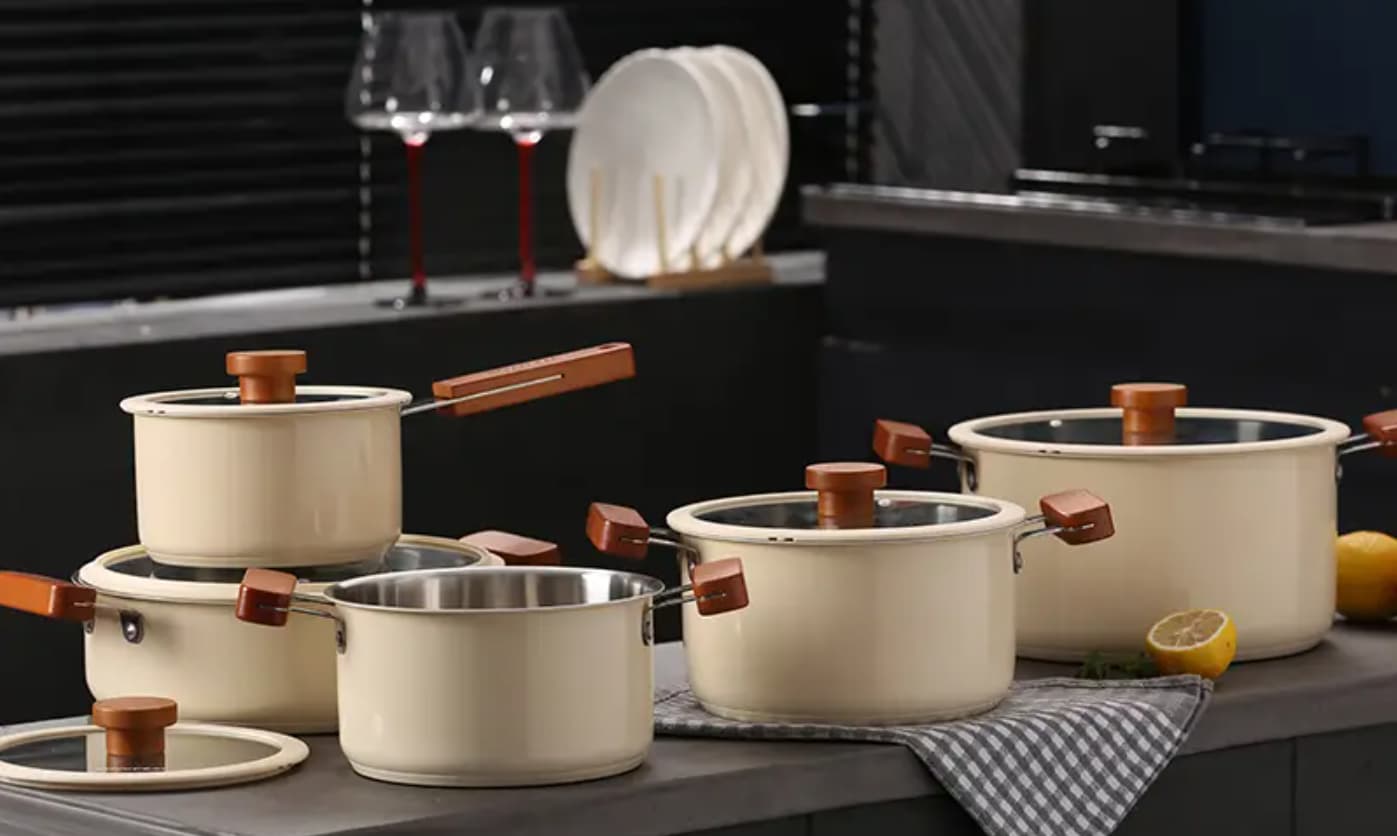
Comparación de 4 tipos de baterías de cocina no tóxicas
| Material de la batería de cocina | Razón no tóxica | Beneficios para la salud | Inconvenientes |
| Batería de cocina de cerámica pura | Fabricado con materiales naturales, sin revestimientos químicos ni sustancias nocivas como PTFE, PFOA, plomo y cadmio. | No desprende sustancias nocivas; apto para cocinar a alta temperatura | Caro, frágil, requiere un manejo cuidadoso |
| Batería de cocina de acero inoxidable | Sin revestimientos químicos, muy resistente a la corrosión, no reacciona con los alimentos | Duradero, apto para freír, saltear y cocer a fuego lento | El acero inoxidable de baja calidad puede lixiviar níquel u otros metales; se recomiendan opciones de alta calidad |
| Batería de cocina de hierro fundido | Sin revestimientos químicos; desarrolla de forma natural una superficie antiadherente | Aporta hierro dietético, ideal para cocinar a alta temperatura | Requiere mantenimiento regular, propenso a oxidarse, no es ideal para cocciones ácidas prolongadas |
| Batería de cocina de acero al carbono | Desarrolla una capa de condimento natural para una superficie no tóxica y antiadherente, sin revestimientos químicos | Ligero, ideal para cocinar a alta temperatura | Necesita mantenimiento para evitar la oxidación; la capa de estaño requiere 1renovación periódica |

Batería de cocina no tóxica 1: Batería de cocina de cerámica pura
La batería de cocina de cerámica pura (no con revestimiento cerámico) se considera una de las más seguras del mercado porque no es tóxica en absoluto y es respetuosa con el medio ambiente.
Razones no tóxicas
La cerámica pura está fabricada íntegramente con minerales naturales y no contiene productos químicos ni revestimientos artificiales. Está completamente libre de sustancias potencialmente nocivas como PTFE (politetrafluoroetileno), PFOA (ácido perfluorooctanoico), plomo y cadmio, por lo que no libera gases ni sustancias químicas nocivas.
Ventajas para la salud
Las baterías de cocina de cerámica pura pueden mantener su estabilidad en entornos de altas temperaturas, garantizando que no se filtren sustancias nocivas durante la cocción. Además, los materiales cerámicos tienen excelentes propiedades de conservación del calor, pueden distribuir uniformemente el calor y reducir los daños a la nutrición causados por el sobrecalentamiento local.
Desventajas
Fragilidad: La cerámica es propensa a romperse al chocar con objetos duros o con cambios drásticos de altas y bajas temperaturas, por lo que debe utilizarse y almacenarse con más cuidado.
Peso pesado: Algunos productos de cerámica pura pueden ser pesados y no son adecuados para métodos de cocción que requieran saltear con frecuencia.
Escenarios aplicables
Es muy adecuado para sopas, guisos o cocciones lentas a baja temperatura, que pueden preservar al máximo el sabor original de los alimentos.
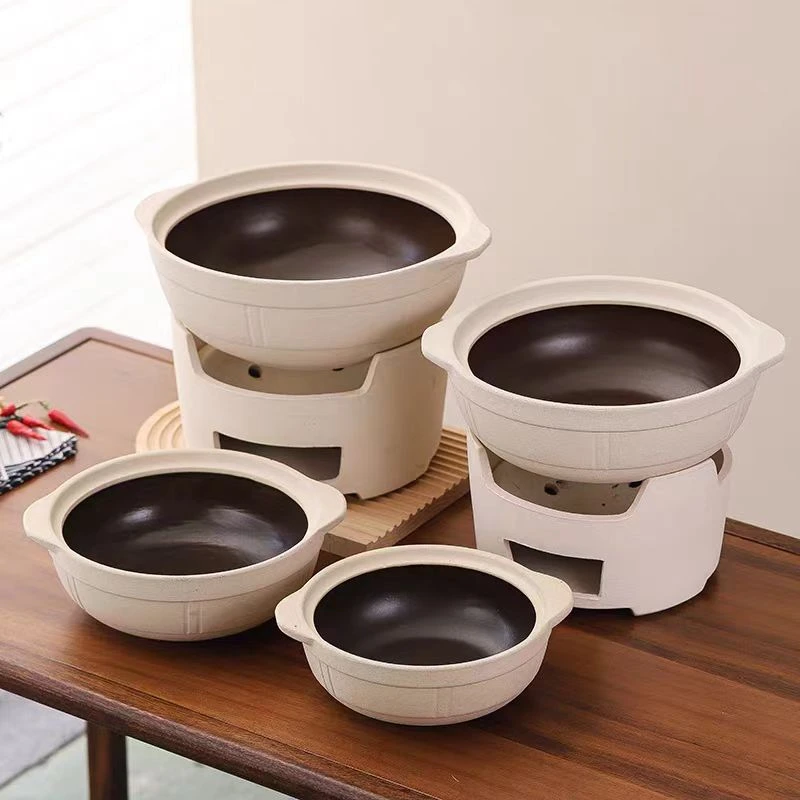
Batería de cocina no tóxica 2: Batería de cocina de acero inoxidable
Razones no tóxicas
Batería de cocina de acero inoxidable no tiene revestimiento químico y es muy resistente a la corrosión. El acero inoxidable de alta calidad no libera iones metálicos nocivos, especialmente en condiciones normales de cocción.
Ventajas para la salud
Versatilidad: Adecuado para diversos métodos de cocción, como freír, saltear, cocer al vapor y hervir.
Fácil de limpiar: La superficie de acero inoxidable es lisa, no es fácil que se adhieran residuos de alimentos y es fácil de limpiar después de su uso.
Gran durabilidad: El acero inoxidable tiene una buena resistencia a los arañazos y puede soportar altas temperaturas y un uso intensivo.
Desventajas
Contenido en níquel y cromo: El acero inoxidable de baja calidad puede contener mayores componentes de níquel o cromo, que pueden liberarse en pequeñas cantidades al cocinar alimentos ácidos, y su uso a largo plazo puede afectar a las personas sensibles. Por lo tanto, deben seleccionarse productos de acero inoxidable marcados con grado alimentario y certificación.
Conductividad térmica general: El acero inoxidable por sí mismo tiene una conductividad térmica débil, y normalmente requiere la adición de capas intermedias de aluminio o cobre para mejorar la conductividad térmica.
Escenarios aplicables
Las baterías de cocina de acero inoxidable son adecuadas para freír, saltear y guisar a diario, y también para entornos como las cocinas de los restaurantes, que exigen durabilidad y eficacia.
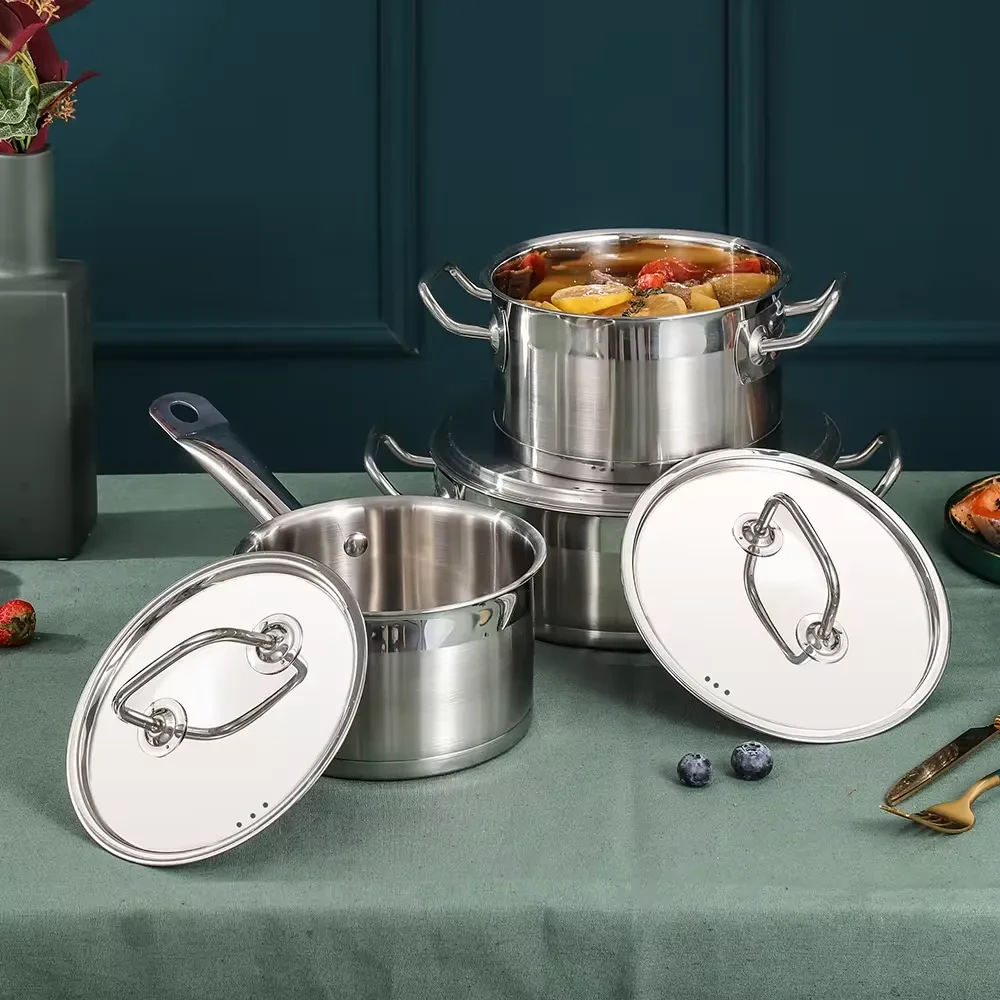
Batería de cocina no tóxica 3: Batería de cocina de hierro fundido
Los utensilios de cocina de hierro fundido son una elección clásica en el mundo culinario por su excelente durabilidad y sus propiedades no tóxicas por naturaleza.
Por qué no es tóxico?
Las ollas de hierro fundido no contienen revestimientos químicos, y durante su uso se forma de forma natural una capa protectora que evita el contacto directo entre el hierro y los alimentos. Además, esta capa protectora natural también ayuda a evitar que los alimentos se peguen a la sartén.
Ventajas para la salud
Suplemento de hierro: Durante la cocción, sobre todo al guisar, pueden liberarse pequeñas cantidades de hierro, lo que constituye un suplemento saludable adicional para algunas personas con carencia de hierro.
Resistencia a altas temperaturas: Las sartenes de hierro fundido soportan temperaturas extremadamente altas, por lo que son ideales para freír, guisar y hornear.
Calor parejo: Las ollas de hierro fundido retienen bien el calor y lo distribuyen uniformemente, por lo que son adecuadas para recetas que requieren una cocción lenta.
Desventajas
Peso pesado: Las sartenes de hierro fundido suelen ser voluminosas y no son adecuadas para saltear.
Requiere mantenimiento: Las sartenes de hierro fundido son propensas a oxidarse o a perder sus propiedades antiadherentes naturales si no se mantienen adecuadamente.
No apto para alimentos ácidos: Cocinar alimentos ácidos durante mucho tiempo puede dañar la capa protectora e incluso provocar una liberación excesiva de hierro.
Escenarios aplicables
Las ollas de hierro fundido son adecuadas para guisar, hornear y cocinar al aire libre, muy apropiadas para platos que requieren un largo tiempo de cocción.
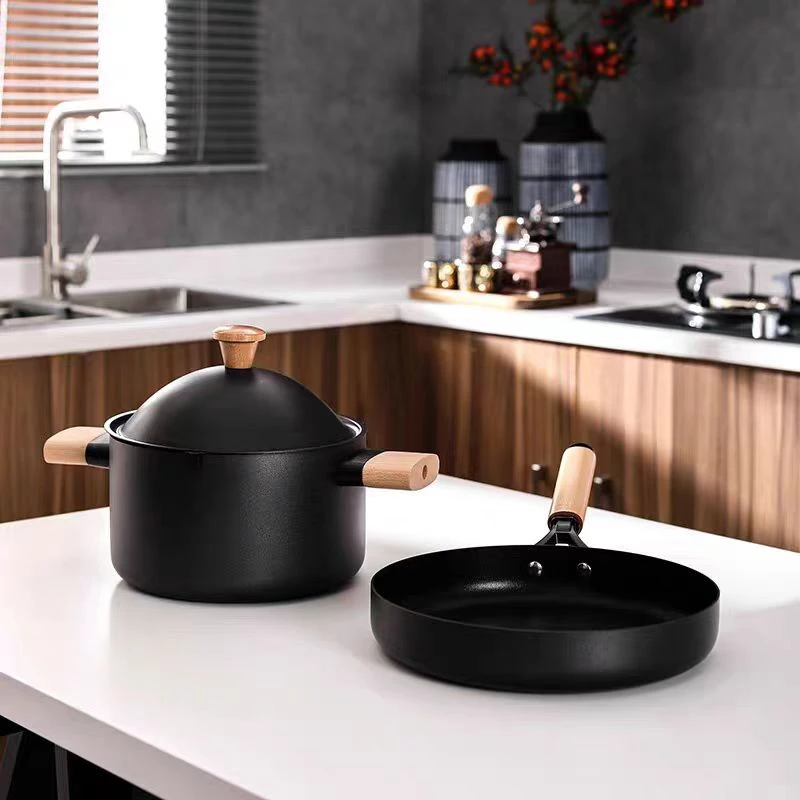
Batería de cocina no tóxica 4: Batería de cocina de acero al carbono
Los utensilios de cocina de acero al carbono se están convirtiendo en una opción saludable cada vez más popular por su menor peso y sus propiedades similares a las del hierro fundido.
Razones no tóxicas
Los utensilios de cocina de acero al carbono proporcionan propiedades antiadherentes a través de una capa de condimento formada de forma natural, completamente independiente de cualquier revestimiento químico.
Ventajas para la salud
Estabilidad a altas temperaturas: Adecuado para saltear y freír a alta temperatura sin preocuparse por la liberación de sustancias nocivas.
Ligero: Más ligero que el hierro fundido, fácil de saltear y mover.
Calentamiento rápido: El acero al carbono se calienta rápidamente, adecuado para platos salteados rápidos.
Desventajas
Propenso al óxido: El acero al carbono es propenso a la oxidación si no se limpia a tiempo o no se almacena adecuadamente.
La capa de condimento necesita mantenimiento: La capa de estaño puede desgastarse con el tiempo y es necesario volver a estañarla con regularidad para mantener su rendimiento.
Escenarios aplicables
La batería de cocina de acero al carbono es ideal para salteados chinos, salteados rápidos y barbacoas al aire libre, especialmente para los chefs a los que les gusta cocinar a altas temperaturas.
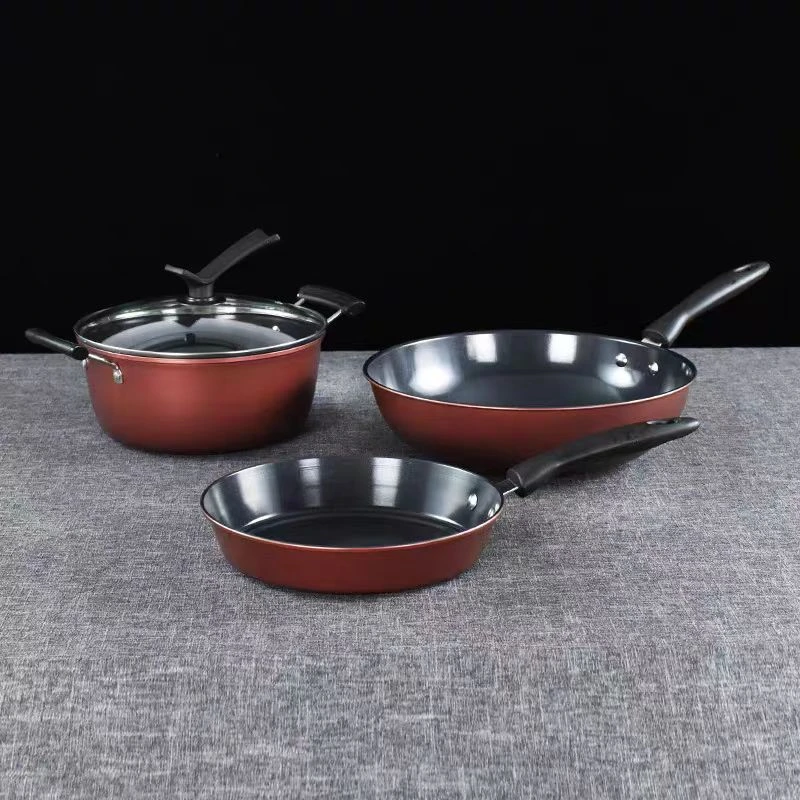
Consejos para elegir utensilios de cocina saludables
Elija la batería de cocina no tóxica más adecuada en función de sus necesidades culinarias y de su presupuesto:
- Los usuarios que prefieran la cocción lenta o la cocción a alta temperatura pueden elegir el hierro fundido o la cerámica pura;
- Se recomienda el acero inoxidable de alta calidad para los utensilios de cocina multiuso de uso diario;
- Los cocineros que prefieran la ligereza y el salteado a alta temperatura pueden probar el acero al carbono;
- Las familias que prefieren una alimentación sana y cocinar con poco aceite pueden optar por las baterías de cocina con revestimiento cerámico.
¿Qué materiales deben evitarse?
Batería de cocina antiadherente tradicional: Las sartenes antiadherentes que utilizan PTFE (teflón) o PFOA pueden liberar gases nocivos a altas temperaturas.
Batería de cocina de aluminio barata: Las sartenes de aluminio que no han sido anodizadas pueden rezumar metal durante la cocción, especialmente con alimentos ácidos.
Batería de cocina esmaltada de mala calidad: Los revestimientos de esmalte de baja calidad pueden desprenderse fácilmente, dejando al descubierto metales potencialmente dañinos.
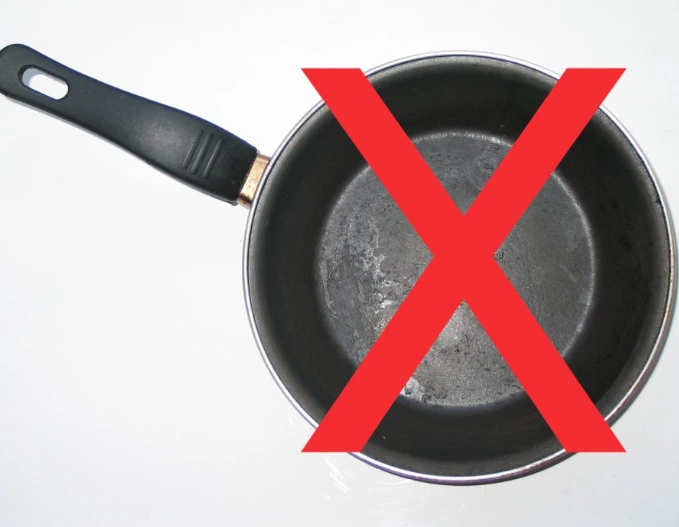
¿Cómo elegir el menaje de cocina no tóxico 100%?
- Preste atención a la certificación: Dé prioridad a los productos que hayan superado la certificación química de inocuidad, como los que llevan la indicación "PTFE, sin PFOA".
- Elija marcas conocidas: La reputación de la marca suele estar vinculada a la calidad del producto y merece la pena invertir en ella.
- Adecuado para su uso: Elija el material adecuado según sus necesidades culinarias personales, como acero inoxidable o hierro fundido para freír, y revestimiento cerámico para cocinar con poco aceite.
Resumen
Los utensilios de cocina no tóxicos Truly 100% incluyen cerámica pura, acero inoxidable, hierro fundido, acero para muelles y otros materiales. No contienen productos químicos nocivos y pueden proporcionarle a usted y a su familia una experiencia culinaria más saludable. Si elige utensilios de cocina seguros y de alta calidad, podrá disfrutar de una comida deliciosa con mayor seguridad y proteger la salud de su familia.
